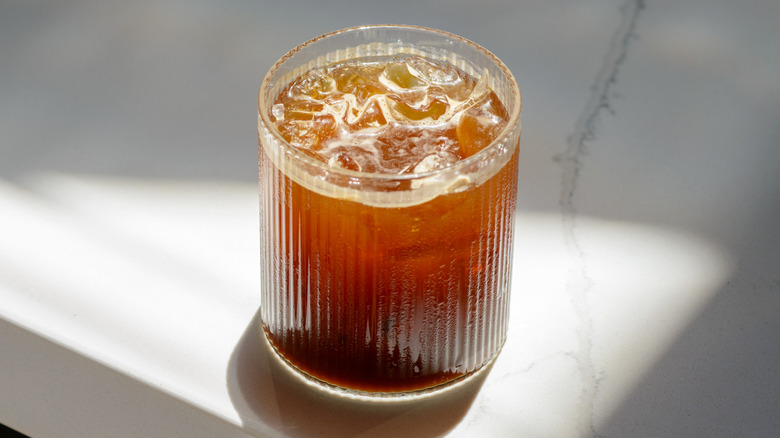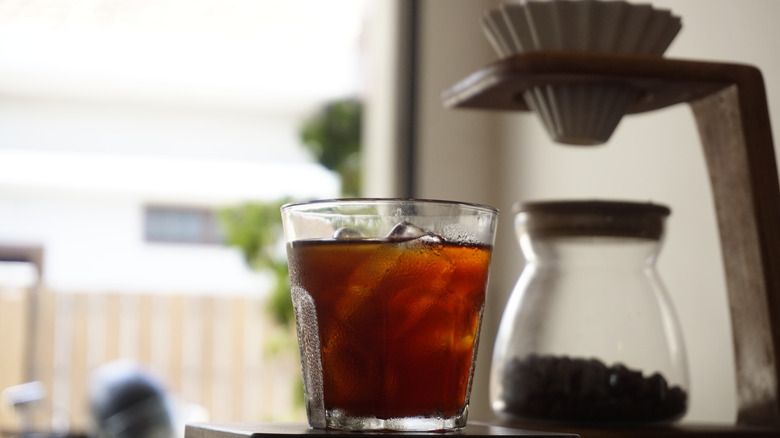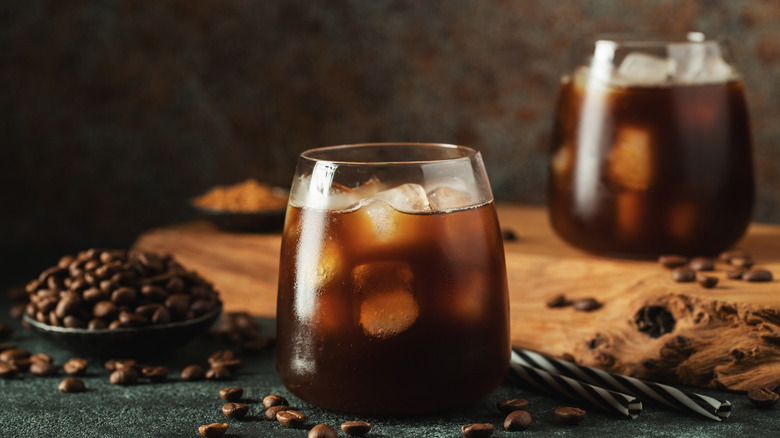What's The Best Way To Brew Iced Coffee?
We may receive a commission on purchases made from links.
Coffee offers twofold appeal. It acts as an energizing pick-me-up and packs delightful flavors. And when you want a refreshing sip, there's the option of iced coffee. From cold lattes to Vietnamese iced coffee, a dizzying number of options exist for a chilled cup of joe. There are various store-bought iced coffee brands that might satisfy you. However, if you're keen to brew your own iced coffee at home, selecting a single best candidate can feel intimidating.
For an option that optimizes flavor, convenience, and only involves simple brewing equipment, turn to the iced pour-over. Also referred to as Japanese iced coffee or a flash brew, this preparation style entails extracting coffee grounds with hot water over ice. In essence, the technique is simple: You brew with less water to craft an extra-strong cup that immediately cools when dripped over the ice. And when prepared with care, the flavors turn out vibrant, balanced, and fruity.
As opposed to preparing a cold brew or hot coffee that's cooled, making iced pour-over leaves little time for oxidation, which means the beans' freshest flavors will come through. Plus, especially with a brewing ritual in place, the entire process can take 10 minutes or less — no need to wait for the coffee's temperatures to slowly drop. So match your employed coffee beans with the optimal recipe, and the iced pour-over rewards with complex flavors.
The iced pour-over yields a bright cup that's best enjoyed straight
Brewing coffee can be as simple or complex as you make it. An iced-pour over rewards attention to detail. The method is best for those who love savouring coffee's nuanced flavors. It brings the full range a brew has to offer: from cocoa-like bitterness, to bright acidity, and all the fruity, floral tasting notes in between.
Consequently, iced pour-overs are best enjoyed straight. If milk, creamer, or sweetener are part of your coffee drinking, a cold brew might be a better choice. This coffee style's muted, robust and cocoa heavy flavors meld better with add-ins and don't shine quite as vibrantly as they do in an iced pour-over. And while you certainly could just cool a classic brewed coffee, this results in an unpalatably bitter cup.
Since you'll brew every cup right before enjoying it, the iced pour-over also allows you to adjust the flavors. Bitterness can be lowered by decreasing the temperature and upping the grind size (acidity can be decreased by going in the opposite direction). You can modify the strength by changing the coffee-water ratio. So as opposed to a cold brew, which is typically batched and can require 18 to 24 hours to seep, you can promptly tailor your iced pour-over from one cup to the next.
The brewing style requires only a few pieces of equipment
If such qualities appeal to you, gather the tools necessary for brewing. As a style of pour-over, you'll need a dripper with a filter like a Hario V60, Kalita Chemex, or similar model. Furthermore, a scale is necessary — any kitchen scale you have laying around will do. And while not absolutely essential, a gooseneck kettle does aid with careful pouring.
Now comes the one steep investment: the grinder. Attaining evenly ground coffee influences the resultant flavor, as well as even extraction. So avoid the cheap and irregular blade grinders, and invest in a burr grinder for full-bodied coffee. The Baratza Encore ESP Coffee Grinder can produce a barista-style brew, while a manual model like the TIMEMORE Chestnut C2 is more economical. Alternatively, you could also ask a barista to grind your coffee at a specialty shop; they can aid in determining the correct grind size, too.
If you're already brewing at home, some of the necessary equipment is likely already around. And you won't need to shell out hundreds of dollars and sacrifice counter space for a machine. Plus, unlike cold brew and store-bought iced coffee, there's no need to give up fridge space.
Many coffees yield a delicious iced pour-over
With a process in place, brewing iced coffee can be an efficient — and hopefully enjoyable — part of your morning routine. The flash-style preparation only requires a few minutes and may even feel relaxing as you slowly pour concentric circles of water over your grounds.
Before you start, you'll need to consider the coffee itself. There's not a bad choice for an iced pour-over, but the technique shines with high quality, intricately flavored beans. Avoid dark roasts to curtail an especially bold brew — a lighter roast will best achieve a balanced cup. There's delicious potential to either a washed or natural process, with the latter delivering the fruitiest brew. And always settle for fresh beans, noting the roast date when you buy it. In comparison to the medium or dark roasts employed in cold brew or Vietnamese coffee, an iced pour-over enables you to enjoy many bean styles.
Since water is the most abundant component in your coffee, you should keep an eye on the kind you utilize. Tap water affects the quality of home brewed coffee; avoid it if it's chlorine-heavy or off-tasting. You'll also need to consider the temperature and water ratio. Like with a hot pour-over, employ boiling, but swap about a third of the water with ice. Thoroughly immerse your grounds to bloom the coffee, and methodically pour water for a few minutes. The result will be delicious.



